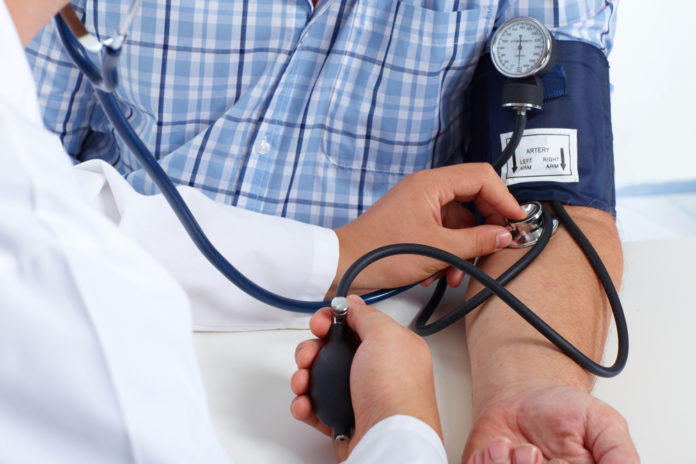What Is Normal Blood Pressure?
Blood pressure (BP) measures the force of blood against artery walls as the heart pumps it. Consistently high BP, also known as hypertension, can weaken and damage blood vessels, in turn increasing the risk of serious heart and health complications. Blood pressure readings include both systolic and diastolic pressures; systolic pressure measures the pressure with each contraction of the heart, or heart beat, while diastolic pressure measures the pressure between each heart beat or pump. Blood pressure is read as systolic over diastolic (systolic/diastolic) with measurements written as millimeters of mercury (mm Hg).
According to new guidelines set by the American Heart Association, adults 65 and older can lower their risk of heart attacks, heart failure, strokes, and death if they are treated similarly to younger adults, with a blood pressure <130/80. The new treatment standard varies from the past, as the systolic pressure had been <140 for people younger than 65 and <150 for people 65 and older. Additionally, the American College of Physicians (ACP) and the American Academy of Family Physicians (AAFP) jointly proposed three recommendations that clinicians…
- “…initiate treatment in adults aged 60 years or older with systolic blood pressure persistently at or above 150 mm Hg to achieve a target systolic blood pressure of less than 150 mm Hg to reduce the risk for mortality, stroke, and cardiac events.” (Grade: strong recommendation, high-quality evidence)
- “…consider initiating or intensifying pharmacologic treatment in adults aged 60 years or older with a history of stroke or transient ischemic attack to achieve a target systolic blood pressure of less than 140 mm Hg to reduce the risk for recurrent stroke.” (Grade: weak recommendation, moderate-quality evidence)
- “…consider initiating or intensifying pharmacologic treatment in some adults aged 60 years or older at high cardiovascular risk, based on individualized assessment, to achieve a target systolic blood pressure of less than 140 mm Hg to reduce the risk for stroke or cardiac events.” (Grade: weak recommendation, low-quality evidence)
Causes and Risks of High Blood Pressure
The causes of high blood pressure vary based on the type, including primary or secondary high blood pressure. Primary, also known as essential high blood pressure, is the most common while secondary high blood pressure is caused by an underlying medical condition and certain types of medications. Once the cause is treated, blood pressure generally goes back within normal ranges. Nonetheless, risks for high blood pressure include:
- Advancing age
- Too much salt or alcohol in the diet
- Limited potassium in the diet
- Being considered overweight or obese
- Taking certain medications
- Living a sedentary lifestyle
- Long-term stress
- Smoking
High blood pressure forces the heart to work harder, subsequently putting strain on the arteries and increasing the risk of a heart attack and stroke. If left untreated, high blood pressure can lead to heart and kidney failure, along with vision changes and eventual blindness. Blood pressure rises and fluctuations have also been linked to cognitive decline and dementia.
How to Lower High Blood Pressure
Most individuals go years without knowing they have hypertension, thus warranting the need for ongoing blood pressure measurements and regular doctor visits. Clinicians will also work in partnership with seniors to create an individualized care plan, predominately considering additional conditions and optimizing health. Additionally, the ACP and AAFP further suggest “that clinicians select the treatment goals for adults aged 60 years or older based on a periodic discussion of the benefits and harms of specific blood pressure targets with the patient.” Commonly used methods to prevent or lower high blood pressure include:
Consuming A Heart Healthy Diet
A heart healthy diet reduces the intake of refined foods, including salt and sugar, and encourages the consumption of whole grains, fruits, vegetables, lean or plant-based proteins, and healthy fat sources.
Losing or Maintaining Weight
Excess weight can force the heart to pump harder for supplying the body with oxygenated blood. While losing weight reduces heart strain, it is important to lose weight as appropriately and carefully as possible, as seniors are already at risk for malnutrition and losing muscle mass.
Exercising
Regular exercise elevates heart rate and improves blood flow, along with managing weight to lessen the risk of heart disease, stroke, and high blood pressure. Learn more about exercise benefits for seniors and expert tips and recommendations here.
Limiting Alcohol and Stopping Smoking
Too much alcohol increases the risk of dehydration, which can consequently increase blood pressure, while smoking interferes with blood flow and oxygen to the brain and is a major risk factor high blood pressure and stroke. So if you do decide to drink, do so in a moderated amount (one serving for women per day and two servings for men) and make sure its consumption does not interfere with medications or health conditions. And if you smoke, there is no better time to quit.
Taking Anti-Hypertensive Medications
Also known as anti-hypertensive medications, there are number of prescription options that can lower blood pressure, especially when lifestyle factors are unable to do so. Commonly used medications include diuretics, beta-blockers, angiotensin-converting enzyme (ACE) inhibitors, angiotensin II receptor blockers (ARBSs), calcium channel blockers (CCBs), alpha-blockers, and alpha-beta blockers. Each work in their own fashion and often a combination of one or two works better than one particular medication.






